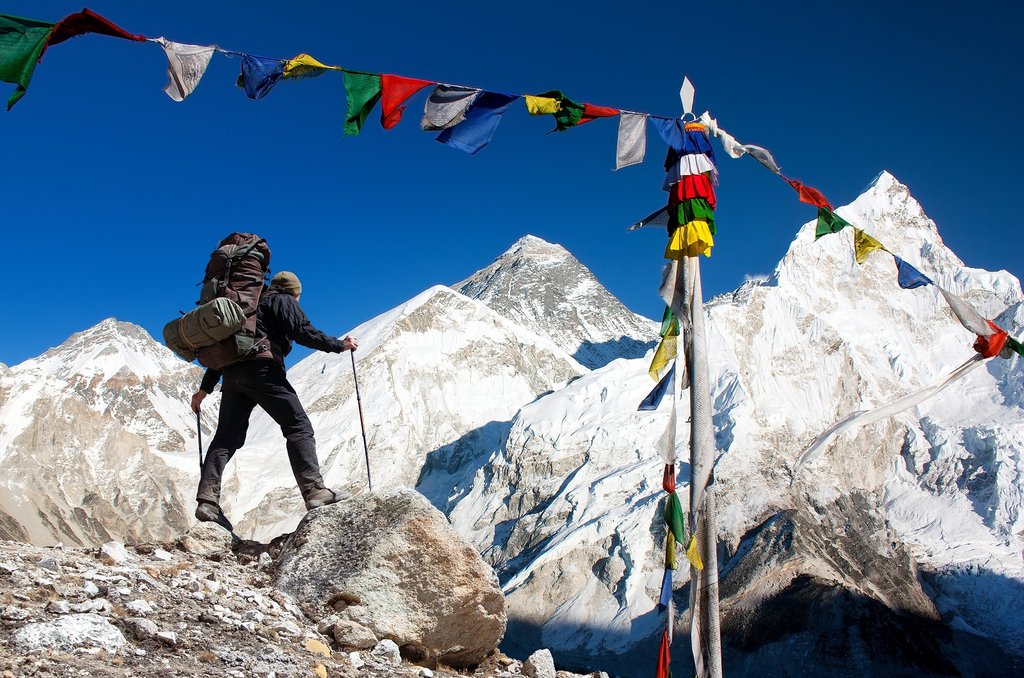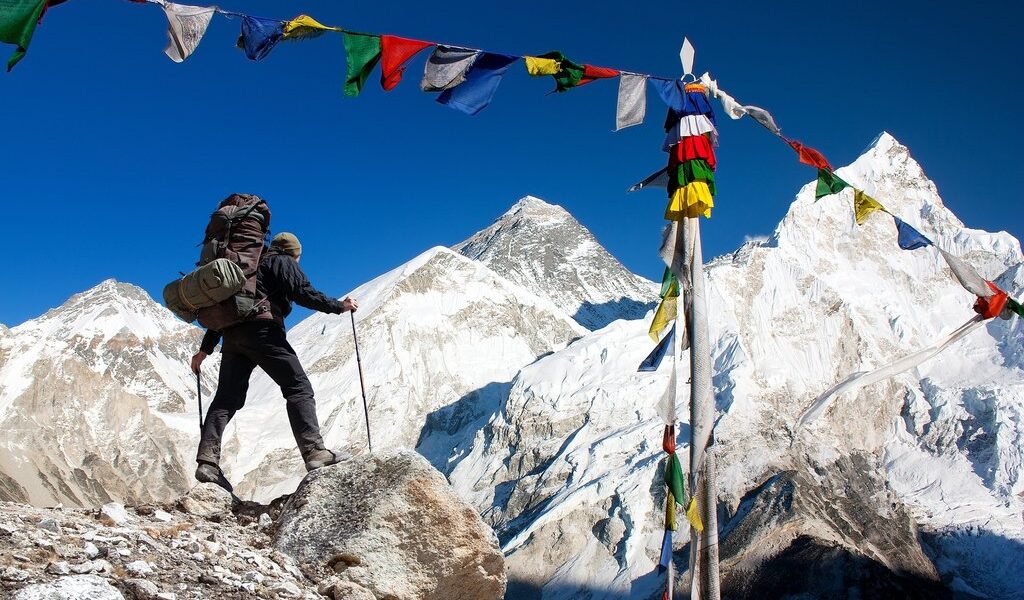
How you get to Everest Base Camp—and the amount of time it requires—depends what side of the mountain you’re approaching from. Most travelers coming from Nepal will come via the classic 8-day trekking route, one of a few longer alternate trekking routes, or on a half-day helicoptor tour. Those coming from Tibet can drive to a less-visited base camp and experienced trekkers can embark on a challenging 5-day hike. Read on to find out more about how long it takes to visit Everest Base Camp.
## Delving into the Majesty of Everest Base Camp: A Comprehensive Guide
Planning a visit to Everest Base Camp (EBC) is an adventure of a lifetime, a journey that etches itself into the memory long after the boots are dusted off. However, the term “Everest Base Camp” can be misleading, as it encompasses not one, but four distinct locations. The primary base camp resides in Nepal, nestled on the southern slopes of the majestic Everest. On the northern side, in Tibet, lie three additional base camps, each offering a unique perspective and experience. Therefore, determining the duration of your expedition to EBC hinges entirely on your chosen destination and mode of transportation.
The experience of venturing to the Tibetan side of Everest diverges significantly from the journey to the Nepali side. In Nepal, the rugged terrain necessitates trekking, as no vehicular roads extend to the remote reaches of the mountains where the base camp is situated. The classic approach involves a multi-day trek through stunning landscapes, immersing oneself in the local culture and breathtaking scenery. However, for those seeking a quicker, albeit more expensive, alternative, helicopter tours to Base Camp are available, offering a bird’s-eye view of the Himalayas.
In contrast, the Tibetan side offers more accessible routes. One can traverse the vast Tibetan plateau in the comfort of a vehicle, allowing for a different kind of appreciation for the scale and grandeur of the region. Each approach to Everest Base Camp offers a unique tapestry of experiences, shaped by the landscape, culture, and the sheer challenge of reaching the foot of the world’s highest peak. Whether you choose to trek through the rugged trails of Nepal or traverse the high-altitude roads of Tibet, a journey to Everest Base Camp is an unforgettable odyssey.
## Exploring Everest Base Camp from Tibet: A Land of High-Altitude Wonders
Tibet, a land of ancient monasteries and breathtaking landscapes, provides an alternative gateway to Everest Base Camp. Here, the journey unfolds in a different rhythm, offering a unique blend of cultural immersion and high-altitude adventure.
### Reaching Everest Base Camp by Car: A Comfortable Overland Adventure
Duration: Allow at least two days of travel from Lhasa to reach the vicinity of Everest.
Within Tibet, the northern approach to Everest features two primary base camps along the North Col climbing route: the well-known ‘Everest Base Camp’ and the ‘Advanced Base Camp’, situated at an even higher altitude. A third, less frequented base camp lies within the remote Kangshung Valley, nestled beneath Everest’s imposing east face. This base camp is a destination rarely visited and is more suitable for very experienced climbers. The most common way for travelers to access EBC in Tibet is via a comfortable, private vehicle, owing to the well-maintained roads that extend almost to the base camp itself.
The journey from Lhasa to the main EBC near Rombuk typically spans two to three days. However, most travelers choose to break up the journey, enriching their experience with stops at captivating destinations such as Gyantse, Shigatse, and Sakya. The quality of the roads may come as a pleasant surprise, especially for those familiar with the more challenging conditions in Nepal, ensuring a relatively comfortable ride. Nevertheless, individuals prone to car sickness or altitude-induced headaches should take necessary precautions. The awe-inspiring vistas that unfold along the route are often considered ample compensation for any discomfort experienced.
The final settlement before reaching Everest is the small village of Rombuk, characterized by its basic guesthouses and ancient monastery. From Rombuk, a partially unpaved road leads towards EBC, a distance of just a couple of miles. While driving all the way to EBC is permitted, many travelers choose to embark on a walk for the final mile or so beyond the parking area. This short trek, however, can prove surprisingly challenging, given the thin air at an altitude of 17,056 feet. Moreover, those arriving overland via vehicle may not be adequately acclimatized, further exacerbating the effects of altitude.
Numerous routes to EBC are available in Tibet, offering a diverse range of experiences. A straightforward overland journey from Lhasa, typically undertaken after a couple of days of acclimatization in Lhasa, follows a general itinerary as described below:
Day 1: Depart from Lhasa and arrive in Gyantse.
Day 2: Journey from Gyantse to the Qomolangma National Park, with a stop at Sakya.
Day 3: Explore Qomolangma National Park and arrive at Rombuk (Everest Base Camp).
Day 4: Travel from Rombuk to Shigatse.
Day 5: Return from Shigatse back to Lhasa.
### Trekking to Everest Base Camp from Tingri: A Challenging Foot Journey
Duration: This trek requires approximately 5 days to complete.
Trekking to EBC on the Tibetan side is far less common than trekking from Nepal, primarily due to the limited infrastructure and the extreme altitudes involved. This option is recommended only for seasoned trekkers with ample high-altitude experience. Prior acclimatization in Lhasa and other locations along the route is crucial before embarking on this challenging trek. Nonetheless, the possibility of trekking to EBC in Tibet does exist for those prepared for the rigors of the journey.
The most popular starting point for this trek is Tingri, located approximately 43 miles from EBC. Accommodation options consist of tents or basic village guesthouses, adding to the rustic nature of the adventure. A typical itinerary for a trek to EBC in Tibet is outlined as follows:
Day 1: Trek from Old Tingri to Lungthang.
Day 2: Hike from Lungthang to Lamna La.
Day 3: Journey from Lamna La to Zommug.
Day 4: Trek from Zommug to Rombuk.
Day 5: Final stretch from Rombuk to Everest Base Camp.
An alternative trekking option involves a challenging route between Rombuk/EBC and Advanced Base Camp, located at a staggering altitude of 21,325 feet. This 17-mile trek typically requires five days to complete and is often cited as the highest trekking trail in the world, underscoring the level of caution and preparation necessary.
## Exploring Everest Base Camp from Nepal: A Trekker’s Paradise
Nepal, often hailed as a trekker’s paradise, presents a more accessible gateway to EBC, attracting adventurers from around the globe. The allure of trekking through the foothills of the Himalayas, immersed in the vibrant Sherpa culture, is a draw for many. For those pressed for time and with sufficient budget, a quick half-day helicopter trip from Kathmandu to EBC is also an option.
Unlike Tibet, Nepal does not offer the possibility of driving to EBC. The road network extends only as far as Phaplu, a considerable distance away, requiring many days of walking. The most common approach involves flying from Kathmandu to Lukla, a small mountain airstrip renowned for its short runway and stunning views. From Lukla, a multitude of trekking routes lead towards EBC, each offering a unique perspective on the breathtaking landscape.
### The Classic Everest Base Camp Trek: A Journey to the Foot of the World
Duration: This trek typically involves 8 days of trekking from Lukla to EBC, including rest days.
The Everest Base Camp trek remains the most popular trek in Nepal, fueled by the magnetic appeal of the world’s highest mountain. Most trekkers commence their journey in Lukla and traverse through the charming settlements of Phakding, Namche Bazaar (the largest town in the region), Tengboche, Dingboche, and Lobuche, before retracing their steps. It is customary to incorporate at least one acclimatization day in Namche Bazaar and another in Dingboche, allowing the body to adapt to the increasing altitude.
### Alternative Trekking Routes: Escaping the Crowds and Discovering Hidden Gems
Duration: These alternative routes typically require 13-21 days of trekking, including rest days.
The classic EBC trek, while incredibly rewarding, can become crowded during peak seasons, particularly in spring and autumn. Trekkers seeking a more secluded and off-the-beaten-path experience can explore alternative routes that offer breathtaking scenery while minimizing encounters with large groups. These routes add several days to the standard EBC itinerary, allowing for deeper immersion in the Himalayan wilderness.
Several notable alternative trekking routes include:
* **The Pioneers’ Route from Jiri:** This historical trail, once used by pioneering mountaineers like Sir Edmund Hillary, adds several days to the EBC trek. Today, it remains a less frequented route, offering a sense of solitude and a glimpse into the region’s mountaineering history.
* **The Three Passes Trek:** This challenging high-altitude trek traverses three very high passes in the Everest region. Best suited for experienced and physically fit trekkers, it provides unparalleled views and a thrilling sense of accomplishment.
* **The Gokyo Lakes Trek:** This stunning trek skirts EBC and continues to the pristine glacial Gokyo Lakes, the highest freshwater lake system in the world. It offers breathtaking scenery and a unique perspective on the Everest region.
* **The Arun Valley Trek:** This remote trek passes through the Makalu Barun National Park before connecting with the EBC route in the Sagarmatha National Park. It provides an opportunity to experience the biodiversity and cultural richness of the eastern Himalayas.
### Reaching Everest Base Camp by Helicopter: A Luxurious Aerial Expedition
Duration: A helicopter tour to EBC typically takes half a day.
For travelers with a generous budget and limited time, a helicopter tour from Kathmandu offers a spectacular and efficient way to experience the majesty of EBC. These tours provide breathtaking aerial views of the Sagarmatha National Park, showcasing the transition from inhabited farmland to tundra and the rugged, rocky terrain at the foot of the world’s tallest mountains.
Helicopter tours usually include a stop in Lukla, and then another stop at a scenic location for breakfast. While a direct landing at EBC may not always be possible due to weather conditions and altitude restrictions, the panoramic views from the helicopter are guaranteed to be unforgettable. These tours typically return to Kathmandu in the afternoon.
An alternative option is to combine a helicopter drop-off or pick-up with a portion of the trek, offering a flexible approach for travelers who wish to experience both the thrill of trekking and the convenience of air travel. This hybrid approach provides the best of both worlds, allowing for a customized Everest experience.
B-1704

